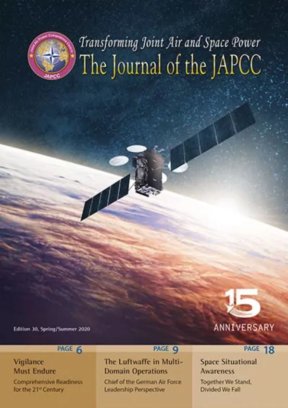Introduction
The space sector is strategic. It offers nations science and technology, industrial power, economic return and military power. Space is becoming more accessible. More countries now have the opportunity to use more or less sophisticated space assets and it is becoming more competitive with the involvement of more private organizations. Overall, space is providing new opportunities, such as new applications and services (5th generation wireless communication (5G), Internet of Things (IoT) and space tourism) or in situ resource exploitation.
Society depends more and more on satellites especially for communications and navigation, but also for meteorological forecasts and many other applications. Many of our daily activities rely heavily on space assets. Those services are taken for granted and have become utilities, but those assets and services need to be protected. Therefore, space warfare will play an increasingly important role in the future. This reliance on satellites makes them primary targets in order to disable enemy capabilities. The possibility to destroy or disable spacecraft is not excessively complicated because both military and civil space assets are essentially vulnerable.
War can be taken to space, with different combat scenarios: Space to Ground, Space to Space or Ground to Space.1 Also from this perspective, access to space is getting easier and cheaper, thanks partly to the development of increasingly capable smaller satellites, which in constellations can generate capabilities comparable to a standard satellite. This, in turn, will provide to any nation an observation capability from space. Consequently, space is becoming increasingly militarized.
On the military side, as well as for commercial or civilian satellites, congestion in space is a major issue due to the increasing risk of collision and the problems associated with the proliferation of space debris.
International Cooperation in Space
The body responsible for international space law is the United Nations Committee on the Peaceful Uses of Outer Space (COPUOS). Among the International treaties negotiated in the COPUOS, the Treaty on Principles Governing the Activities of States in the Exploration and Use of Outer Space, including the Moon and Other Celestial Bodies (the ‘Outer Space Treaty’, 1967) is the most widely adopted treaty, with 104 parties, and it is the foundation of international space law. The guiding principles are that space exploration should be a peaceful initiative and that all nations should have free access to space.
Despite this and other treaties, there are open challenges today with respect to space law2:
- Vertical extent of sovereign airspace.
- Liabilities linked to space debris: debris (accidentally or deliberately created) will continue to increase. If debris causes damage or loss of life down on Earth, the liability is on the launching State. But what if debris causes damage in space?
- New technologies and new business models: the Outer Space Treaty says no nation may appropriate territory anywhere in space, but what about individuals and corporations?
- Militarization of space.
- Outer space: issues like exploitation of natural resources or territorial sovereignty in other bodies is becoming more important as plans to explore and exploit outer space accelerate.
On the other hand, international cooperation is the means to make ambitious space scientific and exploration missions feasible. International cooperation shows today a variable geometry. However, we can identify two sides in this network of alliances: the group of agencies around the United States of America (USA): Europe, Canada, Japan and Russia; and the network being developed by China and their ‘Space Silk Road’3. At the same time, some space powers like India are not yet aligned.
Beyond scientific objectives, there is a clear aim in these missions to explore the possibilities of obtaining and using resources from outer space. It is clear that there are strong economic interests that need to be protected/promoted/made reachable by a Space Force. It appears inevitable that the USA and China will compete for supremacy in space, but it is not yet clear what will be the role of other nations. Space is a long-term project; alliances need to be stable and the natural prolongation of geopolitical alliances need to be maintained. In addition, increasingly easier and cheaper access to space and critical new technologies multiplies the number of potential aggressors within space like terrorist groups or failed states.
Development of New Competences
In this context, any Space Power, integrated into their corresponding Ministry of Defence (MoD) or Department of Defense (DoD) will experience an evolution in the framework of its relationships with other stakeholders. We can mention for instance:
- Public-private cooperation for technology development and even for operations. The National Aeronautics and Space Administration Commercial Lunar Payload Service (NASA CLPS) programme allows contracts with American companies for payload integration and operations, launching from Earth (Space Exploration Technologies – SpaceX) and also landing on the surface of the Moon (Blue Origin).
- Increased coordination with space agencies for elements such as ‘Space Situational Awareness’ or ‘Planetary Protection’.
- Cooperation with Industry: dual technologies to optimize the Resource and Development (R&D) resources and expenditures, spin-offs or side-utilizations of technologies developed by the industry with different purposes.
- Cooperation with Universities in R&D and training as it is being extensively done by the Industry. One example in Europe would be the European Consortium for Advanced Training in Aerospace (ECATA), with the participation of leading Academic Institutions as well as the leading Aerospace Industries with the purpose of designing and delivering a yearly course on management of multinational aerospace projects for highly qualified young engineers.
Space Powers, in order to accomplish their assigned missions, need people developing a variety of different functions. People are changing very rapidly, for example, training and educational institutions are finding newer generations of digital natives with a completely different relationship with machines, technology and especially data handling. The generational gap between our population is increasing at an accelerated pace.
New training methodologies need to be applied, especially in education. Innovation (Project Based Learning) together with new training formats related to wiki, Massive Open Online Courses (MOOC) and Small Private Online Courses (SPOC) are all in development. But above all, the correspondence between the new challenges (scenarios, missions, technologies) and the new people are the new competencies that are needed.
The aerospace industry and academia have been investigating the new competences needed by professionals, mainly but not exclusively engineers4. A similar approach could also be applied by the space forces to their professionals. The concept of the T-shaped professional could be of interest, which is a metaphor for the depth and breadth that an individual has in their competencies. A ‘T-shaped’ engineer is an ideal candidate to be a cross-functional team member.
- Has deep knowledge in at least one area and can be a problem solver in it.
- Understands many other areas and their complexities and knows how to communicate clearly in that area.
- Possesses boundary-crossing competencies mainly related to the ability to work efficiently in a team. For example, communication, critical thinking or processes and engineering practices.
In their Strategic Research and Innovation Agenda (SRIA)5, the Advisory Council for Advance Research in Europe (ACARE) highlights the role of the T-shaped professional in the ‘… understanding of the balance between multi-disciplinary and in-depth knowledge …’ and it continues, ‘We need to ensure engineers are capable of integrating interdisciplinary competencies of a technological, human and social nature as one of the enablers to achieve the aviation goals of 2050 in Europe.’
In the document ‘The Future of Jobs. Employment, Skills and Workforce Strategy for the Fourth Industrial Revolution’6, the World Economic Forum identifies the required top skills for the new professionals:
- Complex Problem Solving
- Critical Thinking
- Creativity
- People Management
- Coordinating with Others
- Emotional Intelligence
- Judgment and Decision-Making
- Service Orientation
- Negotiation
- Cognitive Flexibility
PEGASUS: A Model for European Recognized Skill Profile
Founded in 1998, PEGASUS aims to offer itself as the European portal for higher education services in aerospace, being recognized as the most efficient channel to get university inputs at the integrated European Union (EU) level. PEGASUS is open to all EU institutions providing a sufficiently qualified education in aerospace engineering. Today 28 Institutions from eleven European countries are represented. PEGASUS partners have a reputation for high-quality research and a quality recognition in education and research.
The network’s goals are the following7:
- Contribute to the development of a quality system for the European higher education in Aerospace Engineering.
- Improve educational process and curricula to specifically serve the needs of the aerospace industry.
- Cooperate with other groups and networks to fulfil the EU policy lines in higher education.
- Increase cooperation between partners and industry (PEGASUS Industry Alliance) as well as national and European research agencies (PEGASUS Research Alliance).
- Contribute to attract non-European students and engineers through competitive curricula and continuing educational services.
To develop its activities, the PEGASUS Network also establishes Working Groups (Academic Aerospace Research, Accreditation and Women in Aerospace Engineering), which are non-permanent bodies and modified according to actual needs. Particularly relevant is the Working Group on ‘Aerospace Education and Quality’, aiming at developing a roadmap for quality assurance in aerospace education and monitoring the PEGASUS educational offer in Aerospace Engineering, editing and updating the PEGASUS Course Catalogue.
PEGASUS, as the only European network of excellence in Aerospace Engineering education, has established an entity for developing a quality/excellence label, Promoting Excellence & Recognition Seal of European Aerospace Universities (PERSEUS). Led by PEGASUS, the EC H20208 financed project PERSEUS and has identified a possible roadmap for the definition of a European quality label for aerospace-related higher-education degrees, involving a great portion of the European stakeholders in aerospace: Universities, research centres, industries (both small and large) networks and associations, and accreditation agencies9.
The core concept established by the project is that it is possible to establish a sector-specific quality system, which can complement the existing national or European accreditation systems, providing added value to the internal and/or external quality assurance processes that are in place in most EU Universities.
The proposed method relies on the definition of a set of core skills and abilities both technical and personal, specific for the aerospace domain and expressed in the form of learning outcomes. These skills are identified by all the stakeholders of the higher education process. Once the sector-specific skills are defined, these form the basis for the evaluation of the fitness-for-purpose of the curricula offered at the EU Universities. Each University will be asked to identify the level of achievement of the identified skills, whereas the employers have been asked to rank the importance of each skill for their specific needs. A comparison of the levels offered by the curricula and the needs of the employers would define the employability of the graduates, hence the sector-specific quality of the curricula.
Conclusions
The future is challenging, as it has always been. The environment is changing, as it has always done. The Space Force must prepare for and to anticipate those changes in future scenarios, missions, technologies, vehicles, business models, people, and competences. Space is too big for just one nation; consequently international cooperation is essential. Space power needs to be prepared for various forms of confrontation and different types of threats from different types of contenders. Therefore, new competences have to be trained and acquired.













